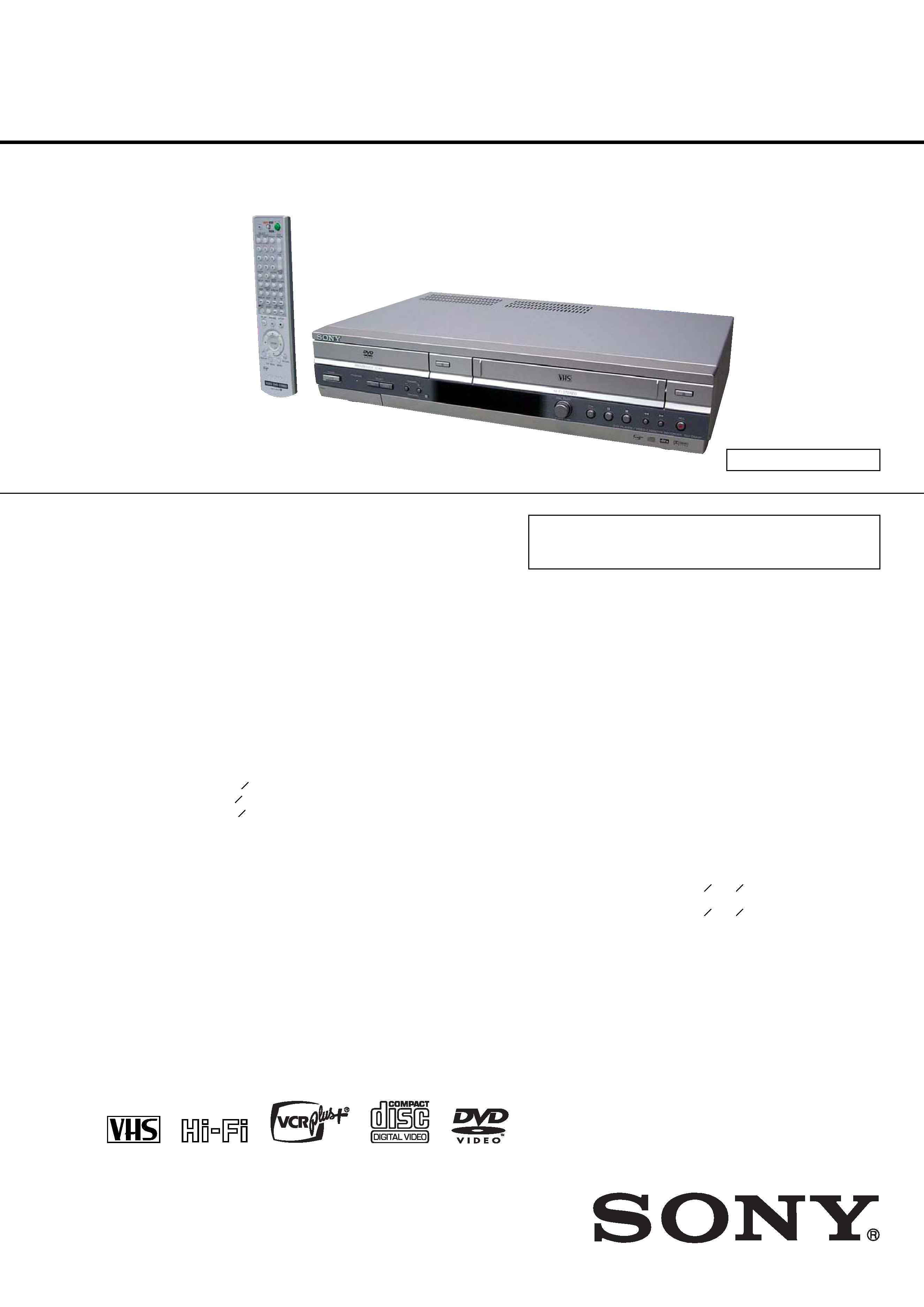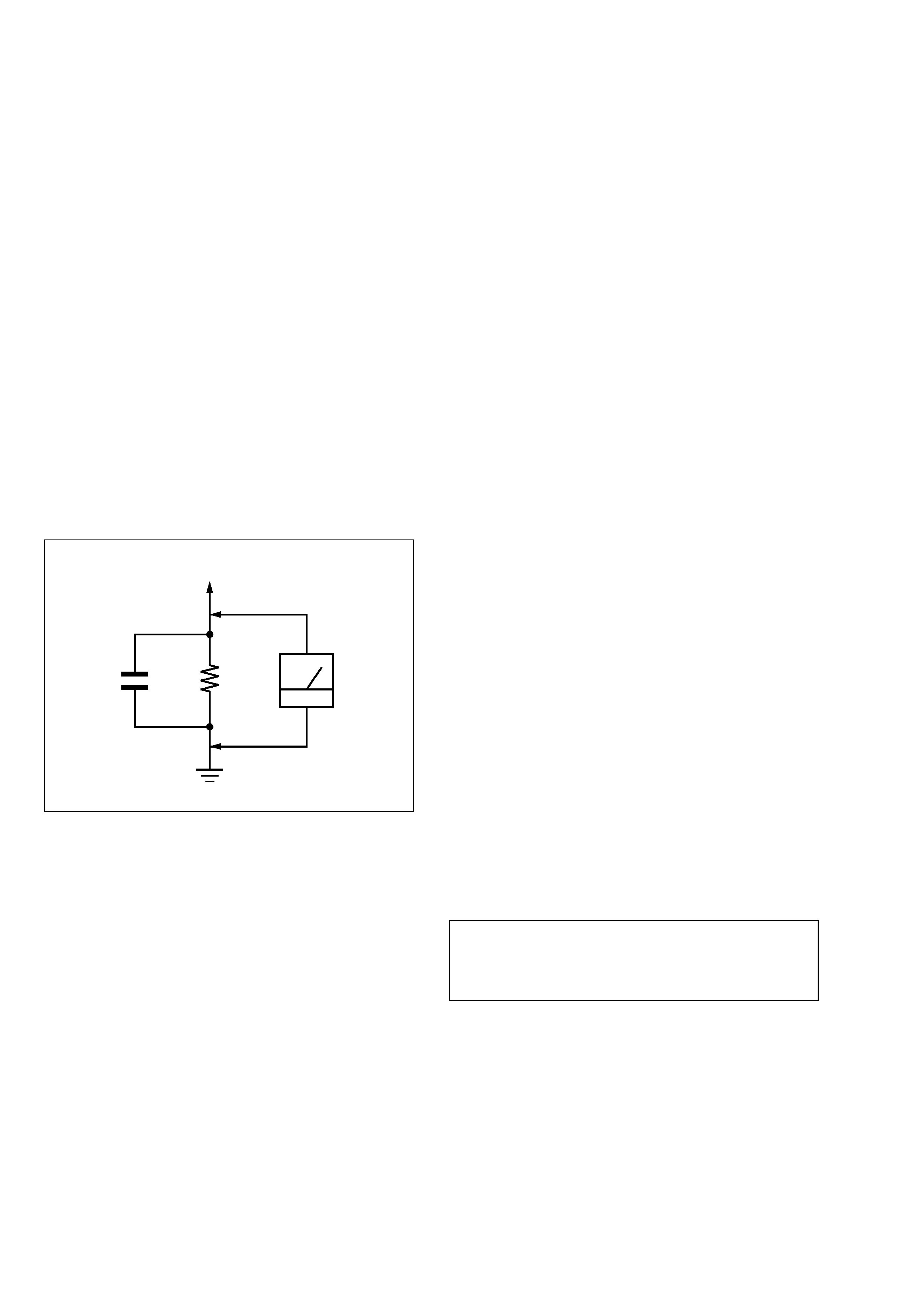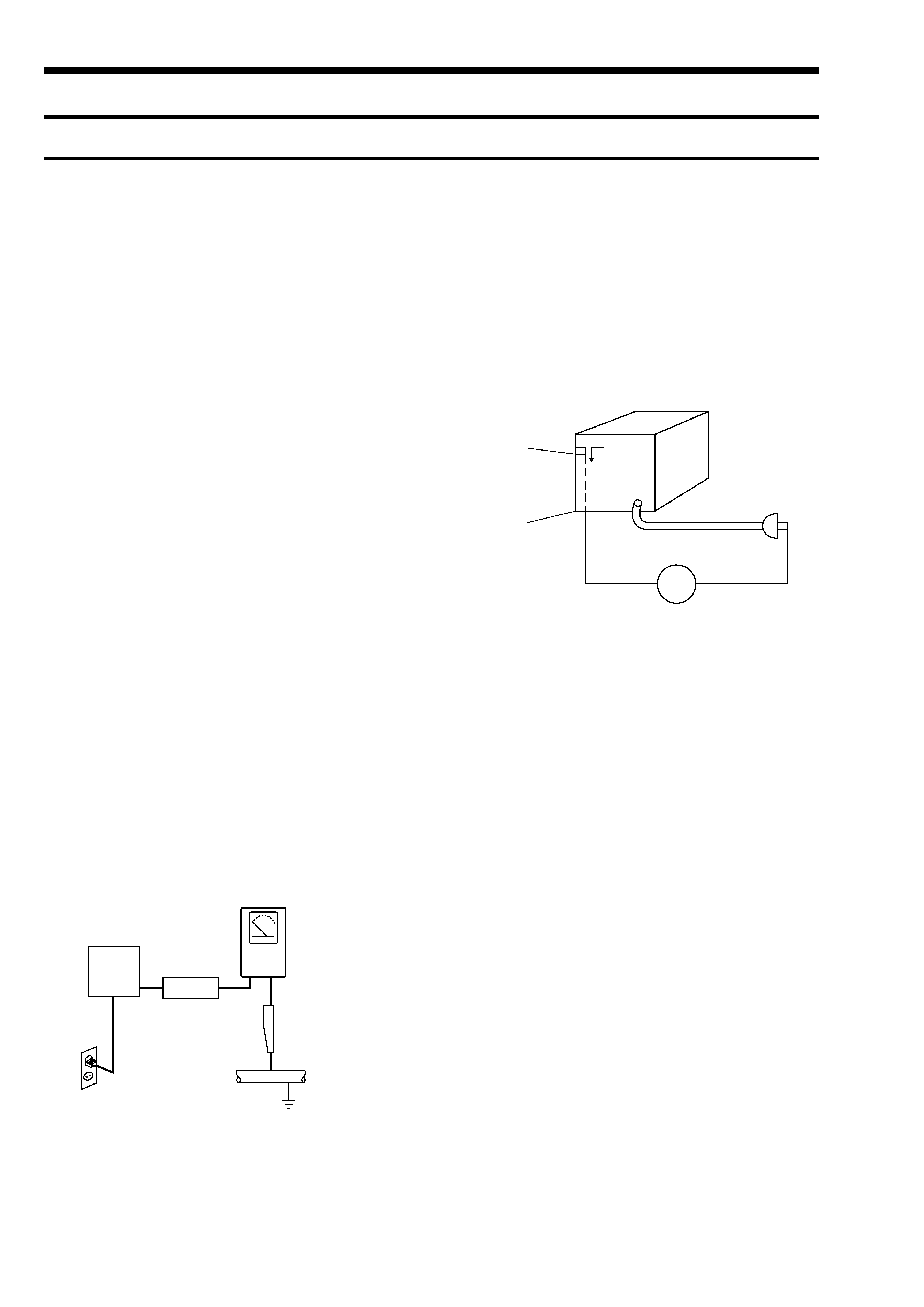
US Model
SERVICE MANUAL
SPECIFICATIONS
SLV-D360P/D560P
RMT-V501E/V501F
TS-10 MECHANISM
Photo: SLV-D560P
RMT-V501F
Refer to the SERVICE MANUAL of VHS MECHANI-
CAL ADJUSTMENT MANUAL VII for MECHANICAL
ADJUSTMENTS. (9-921-790-11)
DVD PLAYER/
VIDEO CASSETTE RECORDER
System
Laser
Semiconductor laser
Format
VHS NTSC standard
Video recording system
Rotary head helical scanning FM system
Video heads
Double azimuth four heads
Video signal
NTSC color, EIA standards
Tape speed
SP: 33.35 mm/s (1
inches/s)
EP: 11.12 mm/s (
inches/s)
LP: 16.67 mm/s (
inches/s),
playback only
Maximum recording/playback time
8 hrs. in EP mode (with T-160 tape)
Rewind time
Approx. 1 min (with T-120 tape)
Tuner section
Channel coverage
VHF 2 to 13
UHF 14 to 69
CATV A-8 to A-1, A to W, W+1 to W+84
Antenna
75-ohm antenna terminal for VHF/UHF
3
8
7
16
11
16
Inputs and outputs
LINE IN 1 and LINE-2 IN
VIDEO IN, phono jack (1 each)
Input signal: 1 Vp-p, 75 ohms, unbalanced, sync
negative
AUDIO IN, phono jacks (2 each)
Input level: 327 mVrms
Input impedance: more than 47 kilohms
LINE OUT
VIDEO OUT, phono jack (1)
Output signal: 1 Vp-p, 75 ohms, unbalanced, sync
negative
AUDIO OUT, phono jacks (2)
Standard output: 327 mVrms
Load impedance: 47 kilohms
Output impedance: less than 10 kilohms
DIGITAL OUT
OPTICAL, Optical output jack
18 dBm (wave length: 660 nm)
COAXIAL, phono jack
Output signal: 0.5 Vp-p, 75 ohms
COMPONENT VIDEO OUT (Y, Pb, Pr)
Phono jack
Y: 1.0 Vp-p/Pb, Pr: 0.7 Vp-p, 75 ohms
S-VIDEO OUT
4-pin, mini-DIN jack
Y: 1.0 Vp-p, unbalanced, sync negative
C: 0.286 Vp-p, load impedance 75 ohms
Timer section
Clock
Quartz locked
Timer indication
12-hour cycle
Timer setting
8 programs (max.)
General
Power requirements
120 V AC, 60 Hz
Power consumption
25 W
Power back-up
Back-up duration: 0 min
Operating temperature
0°C to 45°C (32°F to 113°F)
Storage temperature
20°C to 60°C (4°F to 140°F)
Operating humidity
25% to 80%
Dimensions including projecting parts and controls
(w/h/d)
D560P: Approx. 430 × 85 × 294 mm
(Approx. 17 × 3
× 11
inches)
D360P: Approx. 430 × 85 × 287 mm
(Approx. 17 × 3
× 11
inches)
Mass
Approx. 3.6 kg (Approx. 7.9 lbs)
Supplied accessories
Remote commander (1)
Size AA (R6) batteries (2)
75-ohm coaxial cable with F-type connectors (1)
Design and specifications are subject to change without
notice.
3
8
5
8
3
8
3
8

-- 2 --
WARNING!!
WHEN SERVICING, DO NOT APPROACH THE LASER
EXIT WITH THE EYE TOO CLOSELY. IN CASE IT IS
NECESSARY TO CONFIRM LASER BEAM EMISSION,
BE SURE TO OBSERVE FROM A DISTANCE OF
MORE THAN 25 cm FROM THE SURFACE OF THE
OBJECTIVE LENS ON THE OPTICAL PICK-UP BLOCK.
CAUTION
Use of controls or adjustments or performance of procedures
other than those specified herein may result in hazardous
radiation exposure.
SAFETY-RELATED COMPONENT WARNING!!
COMPONENTS IDENTIFIED BY MARK 0 OR DOTTED
LINE WITH MARK 0 ON THE SCHEMATIC DIAGRAMS
AND IN THE PARTS LIST ARE CRITICAL TO SAFE
OPERATION. REPLACE THESE COMPONENTS WITH
SONY PARTS WHOSE PART NUMBERS APPEAR AS
SHOWN IN THIS MANUAL OR IN SUPPLEMENTS
PUBLISHED BY SONY.
CAUTION:
The use of optical instrument with this product will increase eye
hazard.
Fig. A.
Using an AC voltmeter to check AC leakage.
1.5 k
0.15
µF
AC
voltmeter
(0.75 V)
To Exposed Metal
Parts on Set
Earth Ground
LEAKAGE TEST
The AC leakage from any exposed metal part to earth ground
and from all exposed metal parts to any exposed metal part having
a return to chassis, must not exceed 0.5 mA (500 microamperes).
Leakage current can be measured by any one of three methods.
1. A commercial leakage tester, such as the Simpson 229 or RCA
WT-540A. Follow the manufacturers' instructions to use these
instruments.
2. A battery-operated AC milliammeter. The Data Precision 245
digital multimeter is suitable for this job.
3. Measuring the voltage drop across a resistor by means of a VOM
or battery-operated AC voltmeter. The "limit" indication is
0.75V, so analog meters must have an accurate low-voltage scale.
The Simpson 250 and Sanwa SH-63Trd are examples of a
passive VOM that is suitable. Nearly all battery operated digital
multimeters that have a 2V AC range are suitable. (See Fig. A)
1. Check the area of your repair for unsoldered or poorly-soldered
connections. Check the entire board surface for solder splashes
and bridges.
2. Check the interboard wiring to ensure that no wires are "pinched"
or contact high-wattage resistors.
3. Look for unauthorized replacement parts, particularly transistors,
that were installed during a previous repair. Point them out to
the customer and recommend their replacement.
4. Look for parts which, though functioning, show obvious signs
of deterioration. Point them out to the customer and recommend
their replacement.
5. Check the line cord for cracks and abrasion. Recommend the
replacement of any such line cord to the customer.
6. Check the B+ voltage to see it is at the values specified.
7. Check the antenna terminals, metal trim, "metallized" knobs,
screws, and all other exposed metal parts for AC leakage. Check
leakage as described below.
SAFETY CHECK-OUT
After correcting the original service problem, perform the following
safety checks before releasing the set to the customer:

-- 3 --
TABLE OF CONTENTS
Precautions
1
Safety Precautions ······························································ 4
2
Servicing Precautions ························································ 6
3
ESD Precautions ································································· 7
4
Handling the Optical Pick-up ············································· 8
5
Pick-up Disassembly and Reassembly ······························ 9
1.
General
Getting Started ································································· 1-1
Basic Operations ······························································ 1-7
Advanced Hookups ······················································· 1-15
DVD Settings and Adjustments ····································· 1-16
DVD Additional Operations ·········································· 1-18
VCR Additional Operations ·········································· 1-24
Additional Information ·················································· 1-27
2.
Disassembly and Reassembly
2-1
Cabinet and PCB
2-1-1 Cabinet Top Removal ····················································· 2-1
2-1-2 Bottom Cover Removal ·················································· 2-1
2-1-3 Ass'y Front Panel Removal ············································ 2-1
2-1-4 Function PCB Removal ·················································· 2-1
2-1-5 Chassis Removal ···························································· 2-2
2-1-6 VCR Main PCB Removal ·············································· 2-2
2-2
Circuit Board Locations ················································· 2-3
2-3
VCR Deck Parts Locations
2-3-1 Top View ········································································ 2-4
2-3-2 Bottom View ··································································· 2-6
2-4
VCR DECK
2-4-1 Holder FL Cassette Ass'y Removal ······························· 2-7
2-4-2 Lever FL Arm Ass'y Removal ······································· 2-7
2-4-3 Lever FL Door Removal ················································ 2-8
2-4-4 Slider FL Drive, Gear FL Cam Removal ······················· 2-8
2-4-5 Gear Worm Wheel Removal ··········································· 2-9
2-4-6 Cable Flat Removal ························································ 2-9
2-4-7 Motor Loading Ass'y Removal ···································· 2-10
2-4-8 Bracket Gear, Gear Joint 2, 1 Removal ························ 2-10
2-4-9 Gear Loading Drive, Slider Cam,
Lever Load S, T Ass'y Removal ·································· 2-11
2-4-10 Gear Loading Drive, Slider Cam,
Lever Load S, T Ass'y Assembly ································· 2-11
2-4-11 Lever Pinch Drive, Lever Tension Drive Removal ······· 2-12
2-4-12 Lever Tension Ass'y, Band Brake Ass'y Removal ······· 2-12
2-4-13 Lever Brake S, T Ass'y Removal ································· 2-13
2-4-14 Gear Idle Ass'y Removal ············································· 2-13
2-4-15 Disk S, T Reel Removal ··············································· 2-14
2-4-16 Holder Clutch Ass'y Removal ······································ 2-14
2-4-17 Lever Up Down Ass'y, Gear Center Ass'y Removal ··· 2-15
2-4-18 Guide Cassette Door Removal ····································· 2-15
2-4-19 Lever Unit Pinch Ass'y, Plate Joint,
Spring Pinch Drive Removal ········································ 2-16
2-4-20 Lever #9 Guide Ass'y Removal ··································· 2-16
2-4-21 FE Head Removal ························································ 2-17
2-4-22 ACE Head Removal ····················································· 2-17
2-4-23 Slider S, T Ass'y Removal ··········································· 2-18
2-4-24 Plate Ground Deck, Cylinder Ass'y Removal ·············· 2-18
2-4-25 Hook Capstan, Belt Pulley Removal ···························· 2-19
2-4-26 Motor Capstan Ass'y Removal ···································· 2-19
2-4-27 Post #8 Guide Ass'y Removal ······································ 2-20
2-4-28 Level Head Cleaner Ass'y Removal ···························· 2-20
2-4-29 How to Eject the Cassette Tape ···································· 2-20
2-5
The Table Of Cleaning, Lubrication and
Replacement Time About Principal Parts ···················· 2-21
2-6
DVD Deck
2-6-1 Holder Chuck Removal ················································ 2-22
2-6-2 Tray Disc Removal ······················································· 2-23
2-6-3 Ass'y P/U Deck Removal ············································ 2-24
2-6-4 Ass'y Housing Removal ··············································· 2-25
2-6-5 Ass'y Bracket Deck Removal ······································ 2-26
3.
Block Diagram ·························································· 3-1
4.
PCB Diagrams
4-1
VCR Main/Function-Timer ············································· 4-3
4-2
DVD Main ······································································· 4-7
4-3
Dial-Timer (SLV-D560P Only) ····································· 4-11
5.
Schematic Diagrams
Block Identification of Main PCB ········································· 5-3
5-1
S.M.P.S. ··········································································· 5-5
5-2
Power Drive ····································································· 5-7
5-3
Logic/Function-Timer ····················································· 5-9
5-4
A/V ················································································ 5-11
5-5
Hi-Fi/MTS ····································································· 5-13
5-6
Input-Output ·································································· 5-15
5-7
DVD A/V Decoder ························································ 5-17
5-8
DVD Sub ······································································· 5-19
6.
Alignment and Adjustments
6-1
VCR Adjustment ····························································· 6-1
6-1-1 Reference ········································································· 6-1
6-1-2 Head Switching Point Adjustment ·································· 6-3
6-2
VCR Mechanical Adjustment ·········································· 6-4
6-2-1 Tape Transport System and Adjustment Locations ········· 6-4
6-2-2 Tape Transport System Adjustment ································· 6-5
6-2-3 Reel Torque ··································································· 6-10
7.
Troubleshooting ················································· 7-1
8.
Repair Parts List
8-1
Exploded Views ······························································· 8-2
8-1-1 Cabinet Assembly ···························································· 8-2
8-1-2 VCR Mechanical Parts (Top Side) ·································· 8-3
8-1-3 VCR Mechanical Parts (Bottom Side) ···························· 8-4
8-1-4 DVD Mechanical Parts ···················································· 8-5
8-2
Electrical Parts List ························································· 8-6

-- 4 --
PRECAUTIONS
1 SAFETY PRECAUTIONS
1) Before returning an instrument to the customer, always make a
safety check of the entire instrument, including, but not limited
to, the following items:
(1) Be sure that no built-in protective devices are defective or have
been defeated during servicing.
(1)Protective shields are provided to protect both the technician
and the customer. Correctly replace all missing protective
shields, including any removed for servicing convenience.
(2)When reinstalling the chassis and/or other assembly in the
cabinet, be sure to put back in place all protective devices,
including, but not limited to, nonmetallic control knobs,
insulating fish papers, adjustment and compartment covers/
shields, and isolation resistor/capacitor networks. Do not operate
this instrument or permit it to be operated without all protective
devices correctly installed and functioning.
(2) Be sure that there are no cabinet openings through which adults
or children might be able to insert their fingers and contact a
hazardous voltage. Such openings include, but are not limited
to, excessively wide cabinet ventilation slots, and an improperly
fitted and/or incorrectly secured cabinet back cover.
(3) Leakage Current Hot Check-With the instrument completely
reassembled, plug the AC line cord directly into a 120V AC
outlet. (Do not use an isolation transformer during this test.)
Use a leakage current tester or a metering system that complies
with American National Standards institute (ANSI) C101.1
Leakage Current for Appliances and Underwriters Laboratories
(UL) 1270 (40.7). With the instrument's AC switch first in the
ON position and then in the OFF position, measure from a known
earth ground (metal water pipe, conduit, etc.) to all exposed
metal parts of the instrument (antennas, handle brackets, metal
cabinets, screwheads, metallic overlays, control shafts, etc.),
especially any exposed metal parts that offer an electrical return
path to the chassis.
Any current measured must not exceed 0.5mA. Reverse the
instrument power cord plug in the outlet and repeat the test. See
Fig. 1.
Any measurements not within the limits specified herein indicate
a potential shock hazard that must be eliminated before returning
the instrument to the customer.
(4) Insulation Resistance Test Cold Check-(1) Unplug the power
supply cord and connect a jumper wire between the two prongs
of the plug. (2) Turn on the power switch of the instrument. (3)
Measure the resistance with an ohmmeter between the jumpered
AC plug and all exposed metallic cabinet parts on the instrument,
such as screwheads, antenna, control shafts, handle brackets,
etc. When an exposed metallic part has a return path to the
chassis, the reading should be between 1 and 5.2 megohm. When
there is no return path to the chassis, the reading must be infinite.
If the reading is not within the limits specified, there is the
possibility of a shock hazard, and the instrument must be repared
and rechecked before it is returned to the customer. See Fig. 2.
DEVICE
UNDER
TEST
(READING SHOULD
NOT BE ABOVE
0.5mA)
LEAKAGE
CURRENT
TESTER
EARTH
GROUND
TEST ALL
EXPOSED METER
SURFACES
ALSO TEST WITH
PLUG REVERSED
(USING AC ADAPTER
PLUG AS REQUIRED)
2-WIRE CORD
Fig. 1 AC Leakage Test
Fig. 2 Insulation Resistance Test
2) Read and comply with all caution and safety related notes on or
inside the cabinet, or on the chassis.
3) Design Alteration Warning-Do not alter or add to the mechanical
or electrical design of this instrument. Design alterations and
additions, including but not limited to, circuit modifications and
the addition of items such as auxiliary audio output connections,
might alter the safety characteristics of this instrument and create
a hazard to the user. Any design alterations or additions will
make you, the servicer, responsible for personal injury or
property damage resulting therefrom.
4) Observe original lead dress. Take extra care to assure correct
lead dress in the following areas:
(1) near sharp edges, (2) near thermally hot parts (be sure that
leads and components do not touch thermally hot parts), (3) the
AC supply, (4) high voltage, and (5) antenna wiring. Always
inspect in all areas for pinched, out-of-place, or frayed wiring,
Do not change spacing between a component and the printed-
circuit board. Check the AC power cord for damage.
5) Components, parts, and/or wiring that appear to have overheated
or that are otherwise damaged should be replaced with
components, parts and/ or wiring that meet original
specifications.
Additionally, determine the cause of overheating and/or damage
and, if necessary, take corrective action to remove any potential
safety hazard.
Antenna
Terminal
Exposed
Metal Part
ohm
ohmmeter

-- 5 --
6) Product Safety Notice-Some electrical and mechanical parts
have special safety-related characteristics which are often not
evident from visual inspection, nor can the protection they give
necessarily be obtained by replacing them with components rated
for higher voltage, wattage, etc. Parts that have special safety
characteristics are identified by shading, an (
) or a (
) on
schematics and parts lists. Use of a substitute replacement that
does not have the same safety characteristics as the
recommended replacement part might create shock, fire and/or
other hazards. Product safety is under review continuously and
new instructions are issued whenever appropriate.
